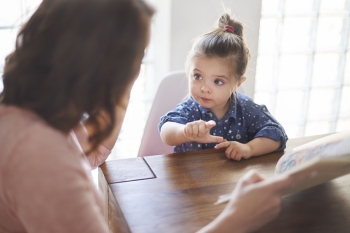
If you have or know a child who has been diagnosed with an Autism Spectrum Disorder (ASD for short) including Autism and Aspergers, you probably know that there are thousands of treatment options available. This tip will highlight social stories, a common treatment tool for children and teenagers with an ASD. Social Stories are short stories that are used to help describe social situations and teach children and teenagers the appropriate social behaviors and reactions to expect during that social situation. Social stories are used to help kids and teens understand the nuances of social interaction. The term “social stories” was coined by Carol Gray in 1991 (www.thegraycenter.org). Social stories can be used to teach children and teenagers about social situations (first day of school, making friends, dating, sex), new settings or activities (going to the movies, getting on a plane, going out to dinner), concepts (public vs. private, white lies vs. truth telling, following the rules, and standing up for yourself) and common responses (how to shake hands, how to order food at a restaurant, how to kiss) that they have not yet experienced. Social stories are NOT designed to correct previously learned behavior. While the concept of social stories was originally designed to help treat the socially inappropriate behaviors of kids with an ASD; many parents, educators and counselors, have found that social stories are a great tool to introduce new information to all types of children. In fact, most parenting books now encourage all parents to utilize social stories as a way to help transition children into a new situation so that they know what to expect. Social cuing is a critical piece of this work.
So what makes a social story different from a regular book or pamphlet about social skills? First of all, social stories are individualized for the person who will be learning a new skill or behavior. Therefore, the child’s name will be included as the “main character” of the story. For example, if you are working with your daughter who is named Julie on learning to ride the school bus, several months before school starts, you would create a social story called “Julie Rides the School Bus,” so she knows what to expect on the first day. Your goal when using social stories is to be highly detailed about the new skill but to leave out any other information that is irrelevant to the behavior being learned. Social stories are also written from the child’s perspective and almost always in first person. Social stories should include a description of the situation, the different types of typical feelings and responses a child might have, what a child may or may not do during the situation, and solutions to common problems that may arise during the situation. Social stories are super repetitive so that they give your child multiple chances to learn the new information being presented to them.
Julie’s story about riding the school bus could go something like this: “When I go to school, I will ride the school bus to get there. The bus will pick me up here at the corner of my street every morning at 7:30 am. The first time I ride the bus I might feel a lot of different emotions, such as happy, scared, nervous, relaxed, and/or grown-up. There will be other kids on the bus too. Some of them will be riding the bus for the first time. If I see someone sitting alone, I can ask to sit next to them. Some kids might be very loud on the bus and some might be quite. Some kids like to talk to their friends on the bus and some take a nap or catch-up on homework. Most kids will try to experiment with different things to do on the bus. I can try taking a nap, sitting quietly or talking with friends too. If I have a problem or need to go to the bathroom, I can tell the bus driver. Bus drivers are good at helping kids in similar situations. To get ready to ride the bus each morning, I will go to the bathroom, get all my school supplies, backpack, and lunch box ready then go outside to the corner of the street to wait with mom, dad, or an older sibling. When I get to school, I will make sure I have all my things, exit the bus carefully, then go into my classroom.”
Now that we have identified what a social story is, and how one is developed, it’s important to understand the theory behind social stories so you can know how to use them for your child. Children with an ASD are known to have difficulty picking up on social cues from others; so social stories cuts this need out by giving clear and accurate descriptions of what’s going to happen, what a person might feel, and what’s an acceptable response via print or pictures. This way children don’t need to worry about who is talking and how it’s being said, like in regular everyday conversations, and they can put all their energy into focusing on what’s being said. Social stories help reduce the anxiety and build confidence around new social situations
How do you use social stories? Well, if you’re the parent of a child with an ASD, start off by identifying the social situations your child has the most difficulty with. For low-functioning children, use a situation that will be happening soon or already happens on a regular basis. Counselors who specialize in working with children with Autism Spectrum Disorders have access to hundreds of social stories they can help you personalize for your child and situation. You can also use your imagination and make a social story from scratch just for your child. Be sure to describe the situation that you want to teach about in as much detail as possible. Highlight when the behavioral problems start, what interventions you have already tried, and the specific settings the issue occurs. Note: in children with very low functioning communication skills, the therapist will work with the primary caregiver alone to create and personalize the story then include the child once the story is completed.
After the story is completed (about 10 to 12 sentences depending on your child’s reading and attention levels), you as the parent or primary caregiver will read the story to your child at least three to five times, even if he or she can read it alone. This is to make sure that the message and instructions are being delivered as clearly as possible. Make sure to only read the story no more than twice per day. After one week, you will make sure your child understand the basics of the story. Depending on the social story acting out a role play can be a useful too, or in other situations questions and answers work best. Once you feel like your child can describe in his or her own words 4 out of 5 basic concepts of the story without help, move on to letting your child read the story to you or with you, if he or she is able. If your child still has difficulty answering questions about the story, read the story one more time then review the concepts again. After each reading of the social story, repeat the review process again.
Social stories are typically be used daily for about two weeks to a month prior to the new event. However, the can be used as often or as long as desired because you can never over prepare your child for a new social situation. If you’re using a story not related to an event, but rather to teach a new social skill in general, aim for the same time frame of daily for two to three weeks. Then with your child’s therapist, observe your child in social interaction and see if he or she has started to use the new behavior. Once your child meets the behavioral goal (i.e. asking for a toy before taking it 3 out of 5 times, or looking a person in the eyes when shaking hands) reduce the reading to one time per week. After you feel like your child has adequately mastered a new behavior swap the current social story out for a new one. Sometimes, you may simply want to try modifying the story to help prepare for the next step, or teach an alternate perspective. You can also engage in the social story telling process orally once your child understands the basic concepts of the new situation. To use the school bus example, you can talk with Julie about what riding the bus is like every time you see a school bus on the road. This can help keep the learning process going and provide an opportunity for you to assess your child’s social skills in real-time. Keep all stories in a file or binder so that you can revisit then as needed, or go back and see a written record of all the progress your child is making.
Social stories are a fantastic tool for teaching social skills to children with an ASD, but also for teaching social skills to anyone. Social stories are always available because you can make one up anytime a new situation arises. They are inexpensive to make, interactive, safe, and non-threatening. They are very detailed about what to expect, what to say, and what to do in new social settings. Social stories are personalized for your child, and make him or her feel a part of the new learning. Social stories can be used at home, in school in the community, or on the go. They are a great addition to traditional behavioral therapies to teach a child what to expect about the nuances of social interaction.
























